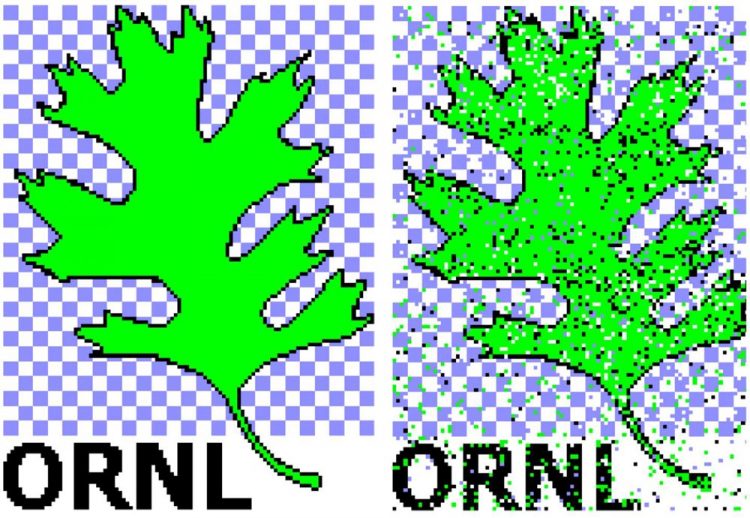ORNL researchers break data transfer efficiency record

The team transmitted the ORNL logo, an oak leaf, between two end points in the laboratory with 87 percent calculated fidelity. (Left): The original 4-color, 3.4kB image. (Right): The image received using superdense coding. Credit: ORNL
The ORNL team transferred 1.67 bits per qubit, or quantum bit, over a fiber optic cable, edging out the previous record of 1.63 per qubit.
The work by ORNL's Brian Williams, Ronald Sadlier and Travis Humble is published as “Superdense coding over optical fiber links with complete Bell-state measurements” in Physical Review Letters. The research was selected as an “Editor's Suggestion,” a distinction reserved for approximately one in six PRL papers.
Whereas computers transmit information in the form of bits (generally represented by either a 1 or a 0), qubits can employ two states simultaneously and therefore represent more information than a traditional bit. The physics of this quantum communication task employed by Williams and his team is similar to that used by quantum computers, which use qubits to arrive at solutions to extremely complex problems faster than their bit-laden counterparts.
Williams' team was the first to use superdense coding over optical fiber, a major achievement in the quest to adopt quantum communication to modern networking technology. And because the team used conventional laboratory equipment such as common fiber optic cable and standard photon detectors, they have brought the technique one step closer to practical use.
As a demonstration of the technique's effectiveness, the team transmitted the ORNL logo, an oak leaf, between two end points in the laboratory.
While the technology is at present largely experimental, practical applications could include a cost-effective way to condense and transfer information. This includes more efficient methods for transmitting and receiving data in application areas such as the Internet and cybersecurity.
“This experiment demonstrates how quantum communication techniques can be integrated with conventional networking technology,” Williams said. “It's part of the groundwork needed to build future quantum networks that can be used for computing and sensing applications.”
###
The work was supported by the United States Army Research Laboratory.
UT-Battelle manages ORNL for the DOE's Office of Science. The Office of Science is the single largest supporter of basic research in the physical sciences in the United States, and is working to address some of the most pressing challenges of our time. For more information, please visit http://science.
Image: https:/
Caption: The team transmitted the ORNL logo, an oak leaf, between two end points in the laboratory with 87 percent calculated fidelity. (Left): The original 4-color, 3.4kB image. (Right): The image received using superdense coding.
NOTE TO EDITORS: You may read other press releases from Oak Ridge National Laboratory or learn more about the lab at http://www.
Twitter – http://twitter.
RSS Feeds – http://www.
Flickr – http://www.
YouTube – http://www.
LinkedIn – http://www.
Facebook – http://www.
Media Contact
All latest news from the category: Information Technology
Here you can find a summary of innovations in the fields of information and data processing and up-to-date developments on IT equipment and hardware.
This area covers topics such as IT services, IT architectures, IT management and telecommunications.
Newest articles

A universal framework for spatial biology
SpatialData is a freely accessible tool to unify and integrate data from different omics technologies accounting for spatial information, which can provide holistic insights into health and disease. Biological processes…

How complex biological processes arise
A $20 million grant from the U.S. National Science Foundation (NSF) will support the establishment and operation of the National Synthesis Center for Emergence in the Molecular and Cellular Sciences (NCEMS) at…

Airborne single-photon lidar system achieves high-resolution 3D imaging
Compact, low-power system opens doors for photon-efficient drone and satellite-based environmental monitoring and mapping. Researchers have developed a compact and lightweight single-photon airborne lidar system that can acquire high-resolution 3D…





















